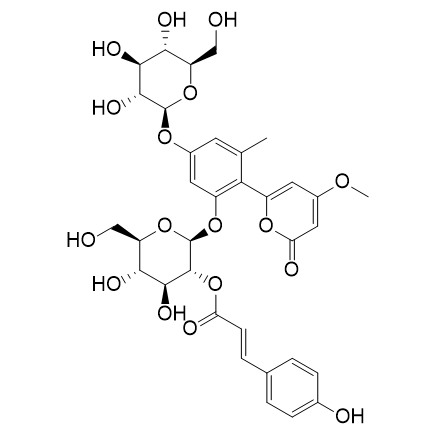Aloenin B
Aloenin B has neuroprotective activity against glutamate-induced neuronal death in HT22 cells.
Inquire / Order:
manager@chemfaces.com
Technical Inquiries:
service@chemfaces.com
Tel:
+86-27-84237783
Fax:
+86-27-84254680
Address:
1 Building, No. 83, CheCheng Rd., Wuhan Economic and Technological Development Zone, Wuhan, Hubei 430056, PRC
Providing storage is as stated on the product vial and the vial is kept tightly sealed, the product can be stored for up to
24 months(2-8C).
Wherever possible, you should prepare and use solutions on the same day. However, if you need to make up stock solutions in advance, we recommend that you store the solution as aliquots in tightly sealed vials at -20C. Generally, these will be useable for up to two weeks. Before use, and prior to opening the vial we recommend that you allow your product to equilibrate to room temperature for at least 1 hour.
Need more advice on solubility, usage and handling? Please email to: service@chemfaces.com
The packaging of the product may have turned upside down during transportation, resulting in the natural compounds adhering to the neck or cap of the vial. take the vial out of its packaging and gently shake to let the compounds fall to the bottom of the vial. for liquid products, centrifuge at 200-500 RPM to gather the liquid at the bottom of the vial. try to avoid loss or contamination during handling.
J Ethnopharmacol.2023, 317:116789.
J Control Release.2024, 375:300-315.
LWT2024, v208:116677
J Chromatogr B Analyt Technol Biomed Life Sci.2022, 1203:123307.
Phytomedicine.2016, 23(4):331-9
Molecules2021, 26(1),230
Food Res Int.2021, 148:110607.
Biomolecules.2021, 11(10):1537.
J Biol Chem.2021, 297(6):101362.
ACS Synth Biol.2022, doi: 10.1021.
Related and Featured Products
Nat Prod Res . 2009;23(11):1035-1049.
New bioactive compounds from Aloe hijazensis[Pubmed:
19521919]
The chemical constituents and biological activities of leaves and roots of Aloe hijazensis, collected in Saudi Arabia, are reported here for the first time. Twenty-two compounds were obtained, among them eight hydroxyquinones: aloe-emodin (1), emodin (2), chrysophanol (3), aloesaponarin II 3-methyl ether (4), ziganein (5), ziganein-5-methyl ether (6a), aloesaponarin I (7) and chrysophanein (8), the dihydro-isocoumarin feralolide (9), 4,7-dichloro-quinoline (10), the triterpene lupeol (11), the anthrone aloin (12), three aloenin derivatives, aloenin (13) ethylidene-aloenin (14), and Aloenin B (15), four flavonoids, quercetin (16), kaempferol (17) cosmosiin (18) and isovitexin (19), and cinnamic acid (20) and two further analogues, caffeic acid (21) and ferulic acid (22). While 15 of the isolated compounds were found in the leaves, 12 were isolated from roots of the plant. Compounds 6a and 10 are reported as new natural constituents, while the compounds 4, 5, 8, and 18 are reported here for the first time from Aloe spp. The structures of the compounds were deduced by intensive studies of their UV, NMR, MS data and by comparison with related structures. The biological activity of plant extracts was studied against various microbial strains, and potent anti-bacterial and anti-fungal activities were found. [image omitted] [image omitted].



